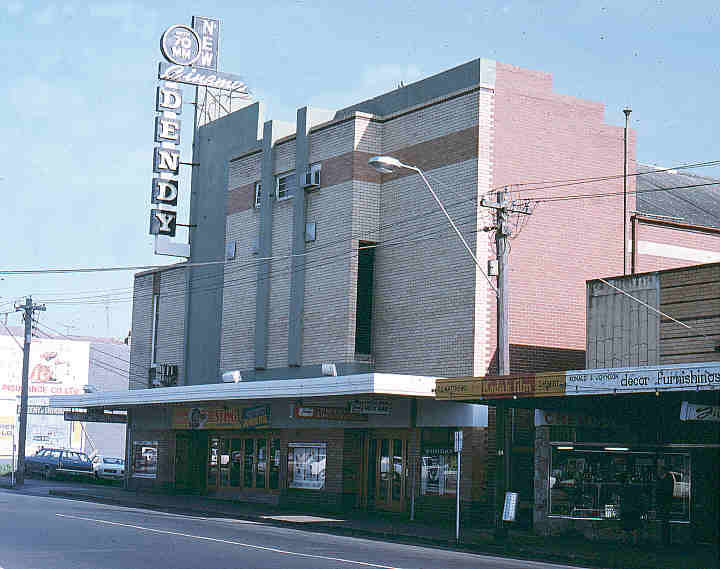
Back to Main Encylopaedia Contents
Dendy Theatre, Brighton

The Dendy Theatre in 1975
The Dendy Theatre in Church Street, Middle Brighton, was built in 1940, and was a typical suburban cinema of its time. The 1172-seat building drew scant praise from theatre architecture specialist Ross Thorne:
"The exterior is a non-descript pastiche of visual elements in face brick and cement render garnished with two signs, one of moulded cement render in the most debased form of moderne lettering, the other a flimsy little vertical sign using a conventional letter face but with each letter separately supported on a square box, the whole topped by a small beacon.
The interior walls had, for the time, rather conventional horizontal bands similar to those in the Regal at Hartwell. Above these bands and across the ceiling were spattered semi-randomly-placed plaster flowers. These stylised incongruities floated in saucers from about two to four feet in diameter. The centre of each was an electric lamp, the petals of plaster picked out in colour." [Thorne, Ross, Cinemas of Australia via USA, p. 137]
It may seem unlikely that this building, thus dismissed with the literary equivalent of a sniff, and named after an early settler in the area, [Building, 24 December, 1940, p. 19] should have become an icon of the theatre organ movement in Australia, and known by name, if not by sight, to theatre organ lovers throughout the world. It was, however, the first public building in Australia into which a theatre organ owned by a preservation society was installed. The opening of that organ thus represented a land-mark, a concrete expression of the resurgence of interest in the instrument in Australia.
The Victorian Division of the Theatre Organ Society of Australia purchased the three-manual, fifteen-rank Wurlitzer organ from the Capitol, Melbourne, in 1963. After they had removed it and placed in into storage, the next step was to find a suitable home in which to install it. In 1965, after many negotiations with the no-doubt initially sceptical management and owners of the Dendy Theatre, agreement was reached for the organ to be installed there.
Unlike some other theatres, no speculative organ chambers had been included in the theatre's design, but fortunately, the Dendy possessed a stage of some depth which was not used. It was found that there was sufficient space on the stage to construct chambers to house the organ behind the screen, an unusual, but by no means unsatisfactory, location.
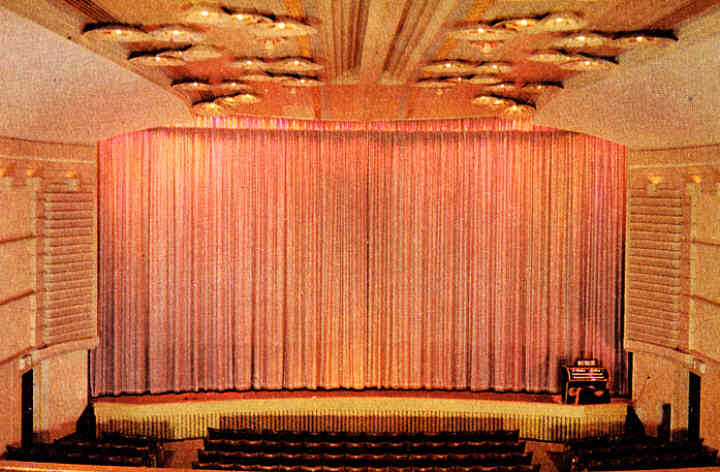
An electronic organ was featured while the Wurlitzer was being installed
The chambers were soon constructed, and on 27 March, 1966, the 32ft Diaphone pipes and the piano, both sited on top of the chambers, were in position. These were the first portions of the organ to be installed.[Vox, TOSA(Vic),April, 1966, p. 1] As the remainder of the organ's parts were set up in the chambers, its relay system was completely rewired. Twenty miles of wire were used in the process. [Inaugural Concert Programme, Dendy Theatre, 30 April, 1967, p. 5] By October, 1966, work had progressed to the point where it was announced that the organ would be opened early in May by English organist George Blackmore, who would play the organ for a three-week season. Horace Weber, long associated with the organ when it was at the Capitol and who had opened it there in 1924, would perform the actual opening items at the première concert. [Vox, October, 1966, p. 2] Blocked drains at the theatre caused the chambers to be flooded to a depth of two inches over Christmas, 1966, but quick action by TOSA members prevented the organ from suffering any damage; fortunately at this stage the console was not yet installed in its lift pit. Work on the installation was, however, set back about a week. [Vox., February, 1967, p. 1]
Finally, after some 20,000 hours of work, the instrument was entrusted to Hill, Norman & Beard Ltd., to carry out final regulation and adjustment.[The First Twelve Months, TOSA (Vic), 1968, p. 2] All was then ready for the organ's unveiling, at 8:00 p.m. on Thursday, 27 April, 1967. Organ music was not new to the Dendy, as a Burge electronic organ had been on the right-hand side of the stage for some while, but at last, genuine pipe sounds were to be heard for the first time.
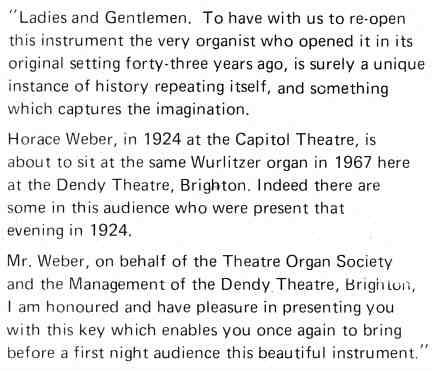
"Tremendous applause greeted Horace Weber, as he rose with the magnificent spotlit console, gleaming in its rich mahogany finish. A similar ovation was accorded Horace as he descended after his selection, which included 'Look for the Silver Lining', played at the opening of the Capitol in 1924." [The First Twelve Months, TOSA (Vic), 1968, p.6]
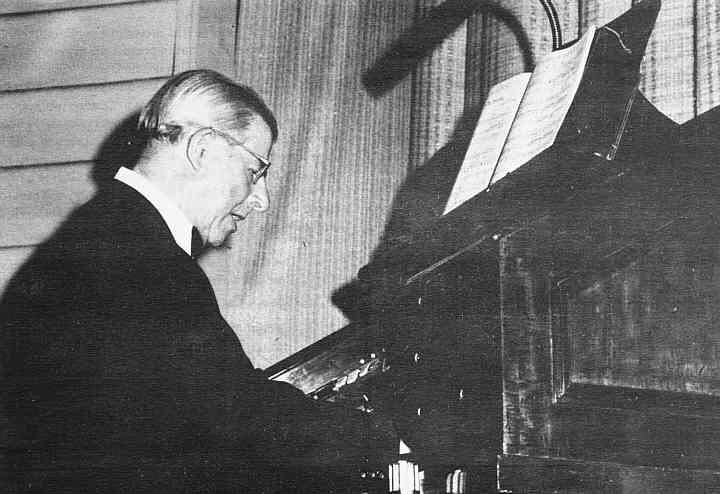
Horace Weber unveils the Dendy organ nearly 43 years after he opened the same organ in the Capitol
George Blackmore, who had arrived from England four days earlier, then played for twenty minutes, including the "Dendy March", which he had written specially for the occasion. The audience then settled back to enjoy the Australian première of the film "Zulu".
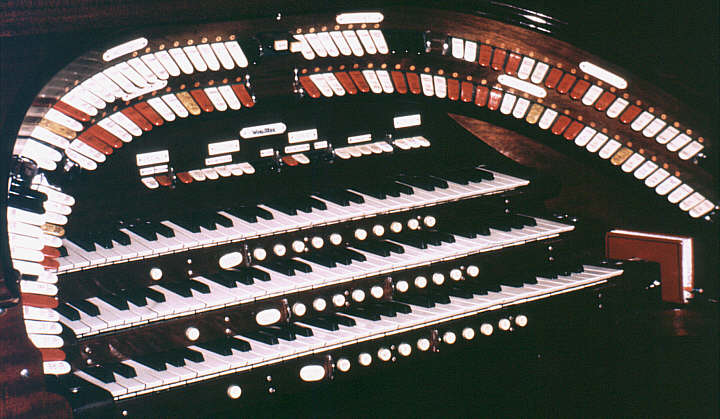
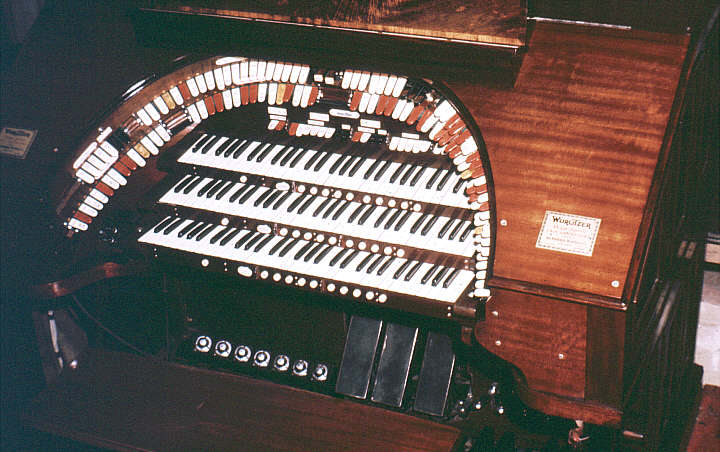
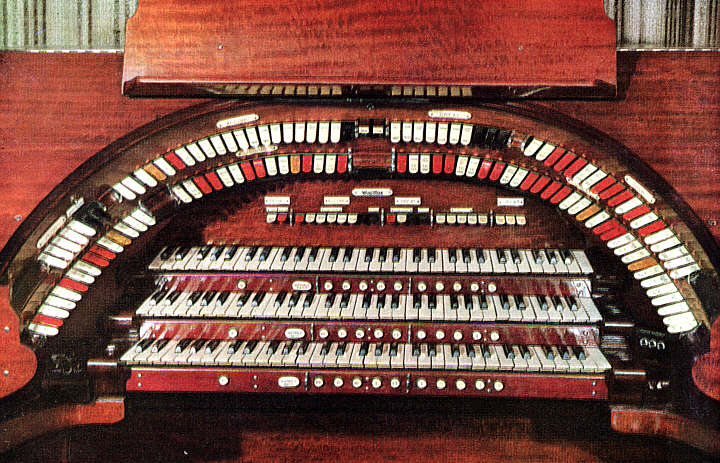
Photgraphers unknown for the three above photographs
The opening, which was a special feature of a film show, gave the audience only a short sample of the organ's sounds. The following Sunday afternoon saw the Inaugural Concert, when George Blackmore really put the organ through its paces.
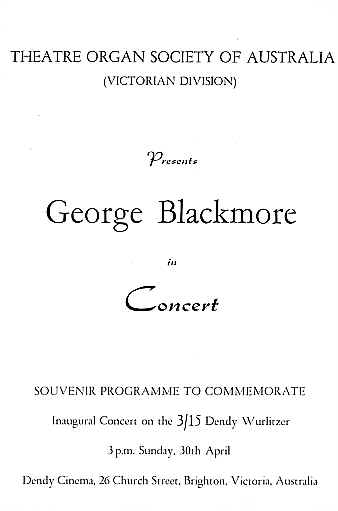
This was a full-scale concert, which included a wide range of music, from Widor to current popular tunes. George's programme was as follows:
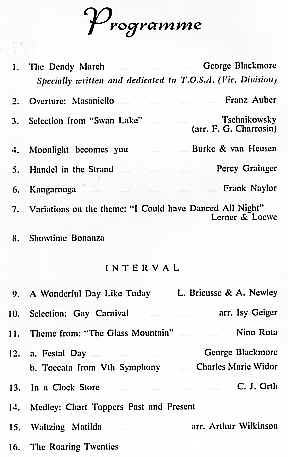
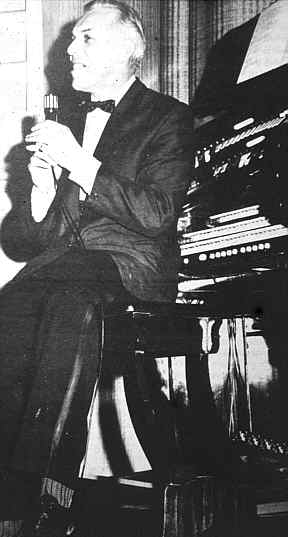
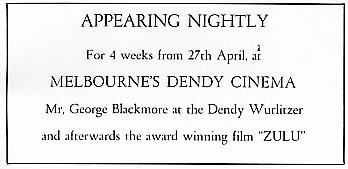
For the next four weeks, George Blackmore played the organ six nights per week (and Saturday matinées), and for more concerts, before returning to England. While he was at the Dendy, he recorded material for an LP record, which was issued in America and released worldwide, to let theatre organ aficionados throughout the world share the delights of the Dendy organ.
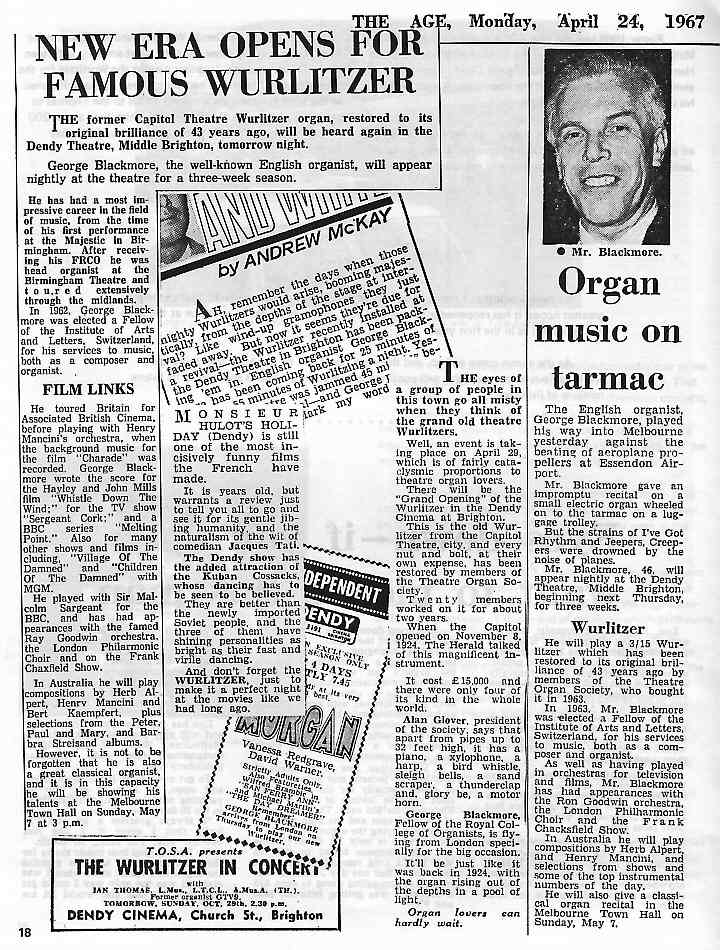
Some examples of media coverage of the organ's first year at the Dendy
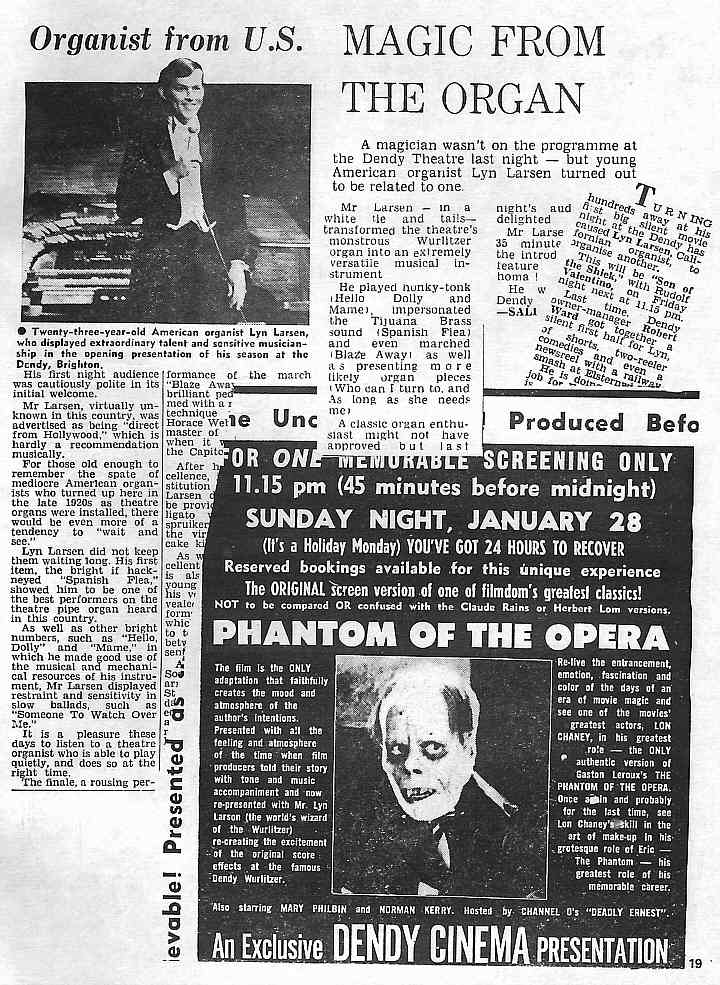
The organ at the Dendy was installed unaltered from the Capitol, except for some tonal adjustment to suit the different auditorium. One rank, the Saxophone, was not able to be restored by Hill, Norman & Beard Ltd. in time for the opening season. Fortunately, TOSA member Bill Glasson had in his residence organ an identical set of Wurlitzer pipes, and these were loaned until the original rank was reunited with the rest of the organ in July, after being fitted with new reed tongues. [Vox, August, 1967, p. 6] The organ console was restored to its 1924 appearance, in varnished dark wood, without the ormolu mouldings added while it was at the Capitol (these were later used by TOSA on its organ at Cinema North, Reservoir). It was placed on a lift, in front of the stage, on the left-hand side of the auditorium. For a short period a Compton Tuba was added, raising the rank complement to sixteen. Comparison of the Dendy and Capitol specifications shows a few changes that have occurred over time.
.jpg)
Console in 1975 when piston mechanism was removed for overhaul
The organ continued to be featured almost every night for the next decade and a half. It was played by both local and international organists. Some of these, such as Lyn Larsen and Vic Hammett, came for several extended seasons, as the instrument became a vehicle for the enjoyment of some of the world's greatest theatre organists.
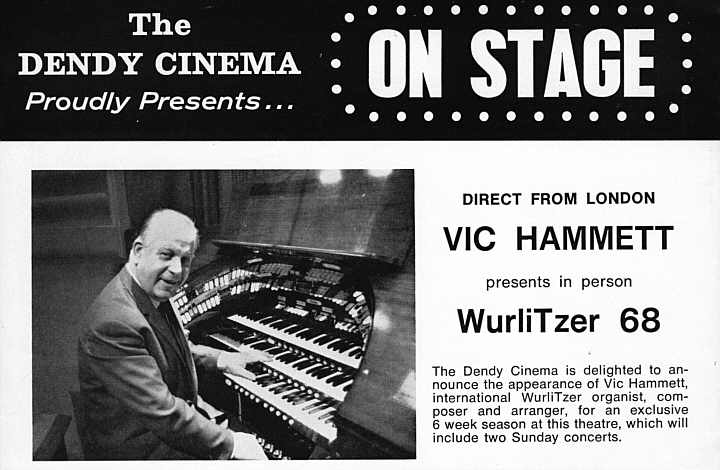
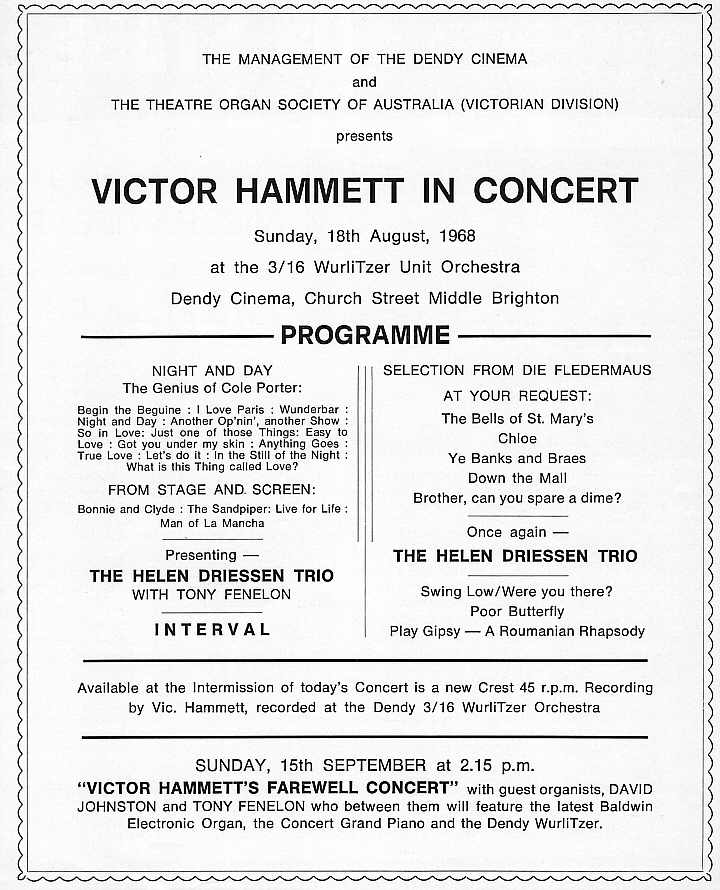
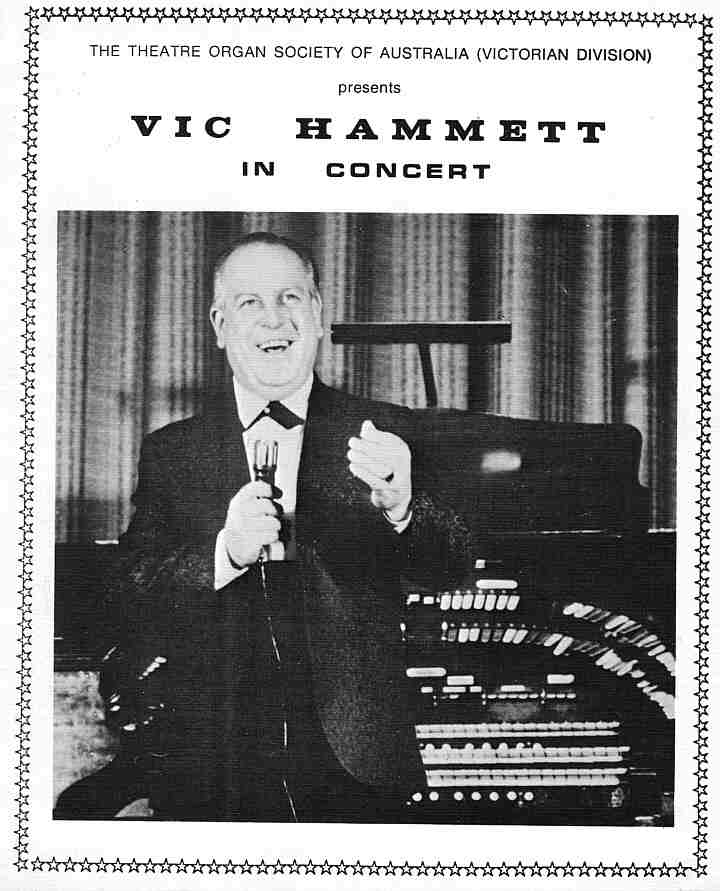
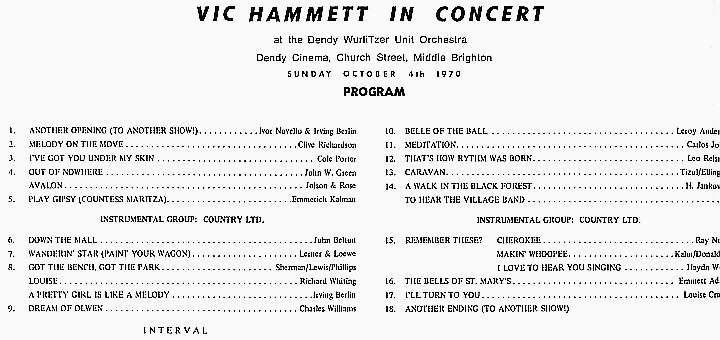
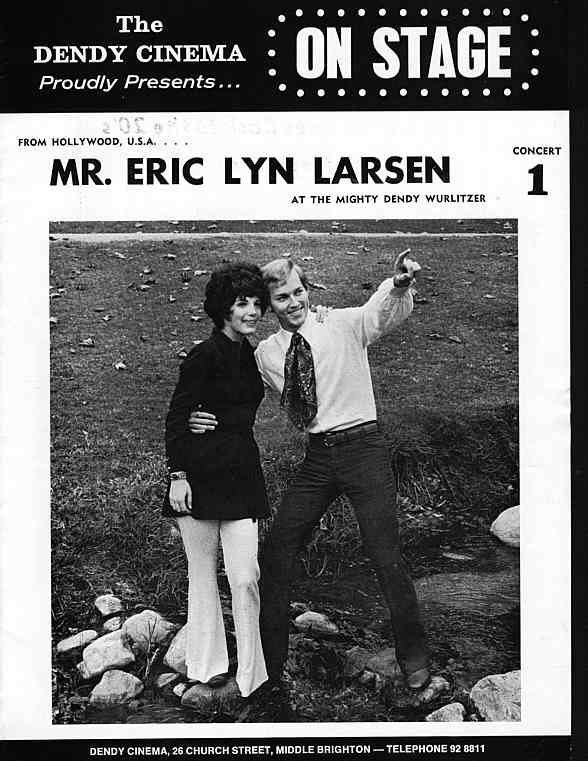
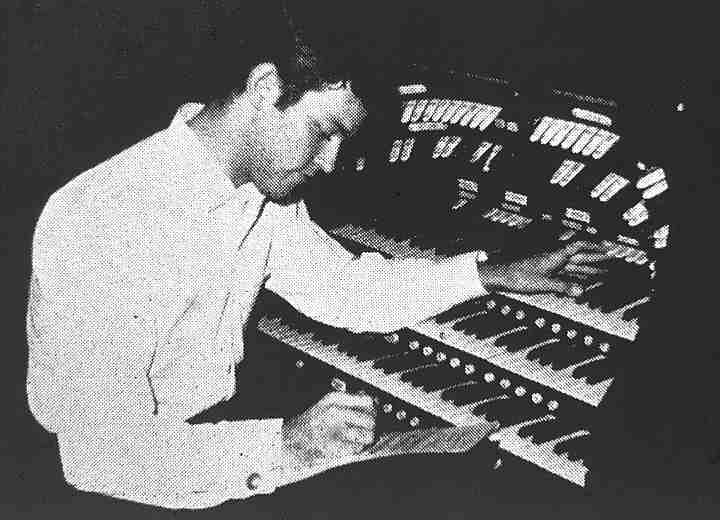
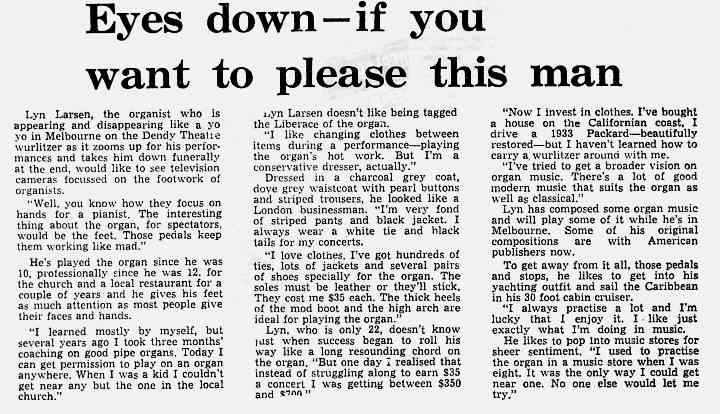
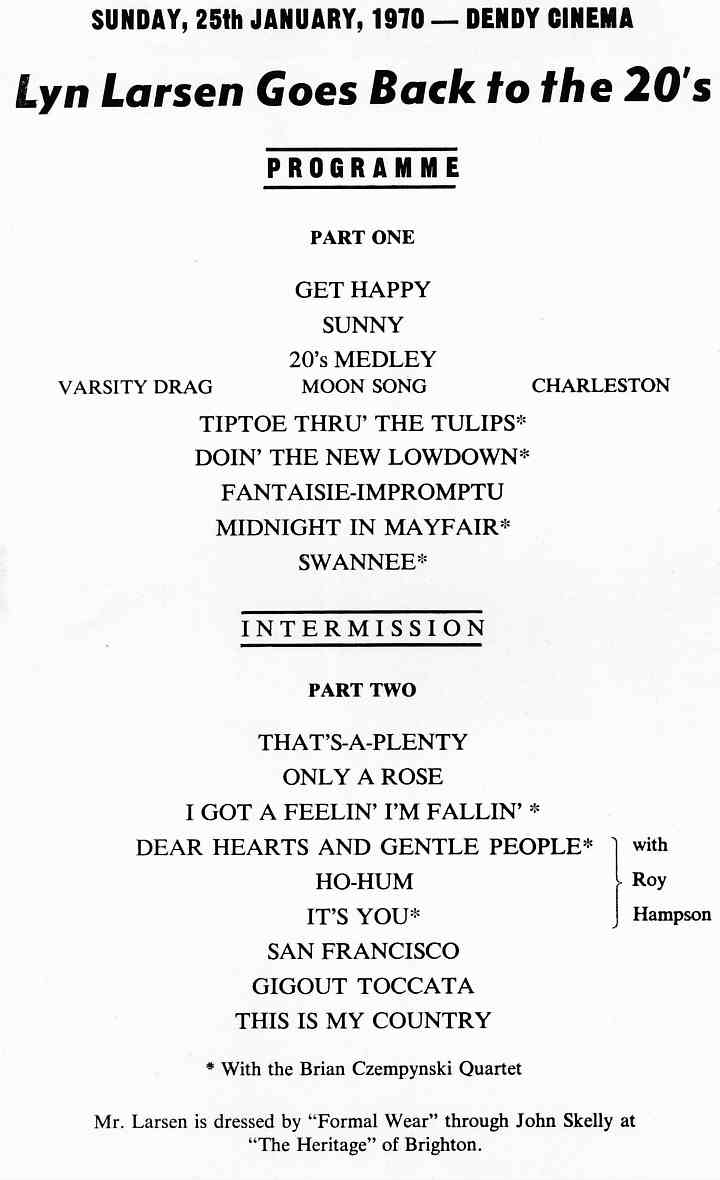
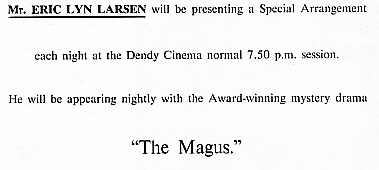
It was regularly used for TOSA's many series of concerts, and rapidly established itself as a major venue on the world concert circuit. Its success inspired other TOSA Divisions to acquire and install organs of their own.
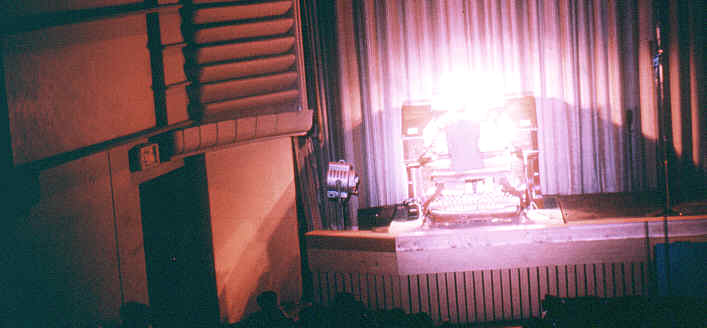
Even the theatre management was so swept away that in their vision for expansion of the Dendy they planned an organ-equipped restaurant. They brought over a three-manual, eight-rank Compton organ, from the Gaumont Theatre, Cheltenham, in England, for that purpose, and placed it in storage at the theatre pending the construction of the restaurant. Unfortunately, that plan never materialised, and the Compton was eventually sold to TOSA in Canberra, who installed it instead in the Albert Hall, Canberra.
The Dendy organ was seen on television a number of times. In particular, it was creatively featured with organist Lyn Larsen in a monochrome cigarette commercial, and in a splendid episode of ABC's "The Music Masters", when it was played by Dennis James, including some exciting duets with Heidi James on piano. Viewers were also taken on a conducted tour through the organ chambers. [Videotapes in my personal archive]
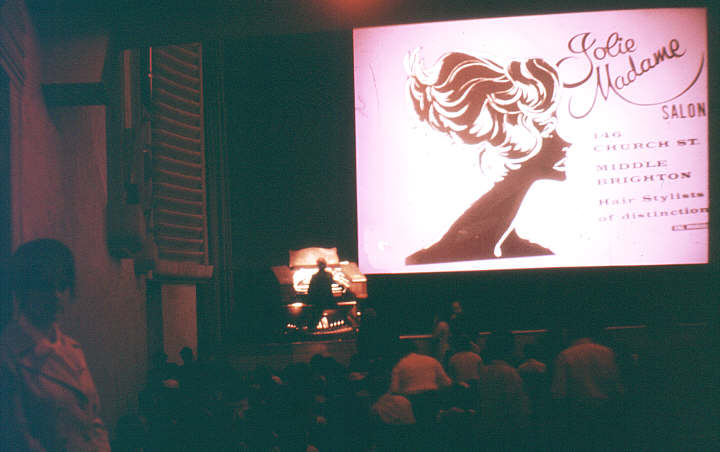
Intermission at the Dendy - David Johnston at the Console - David was house organist at the Dendy for several years
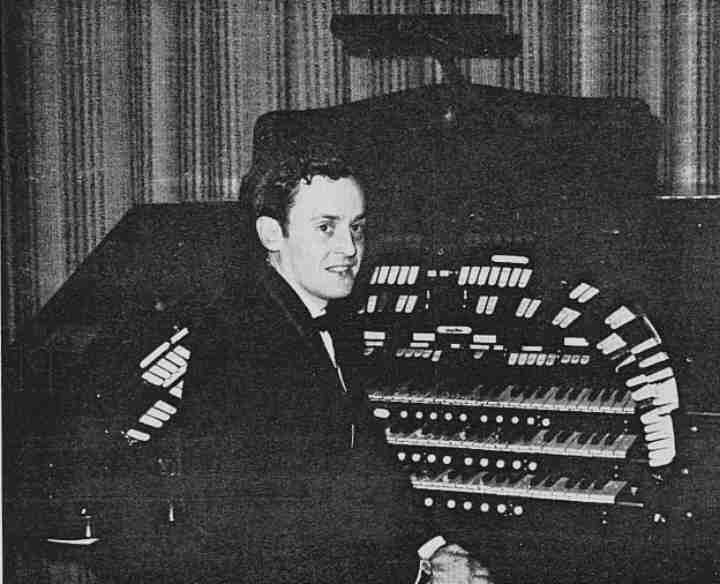
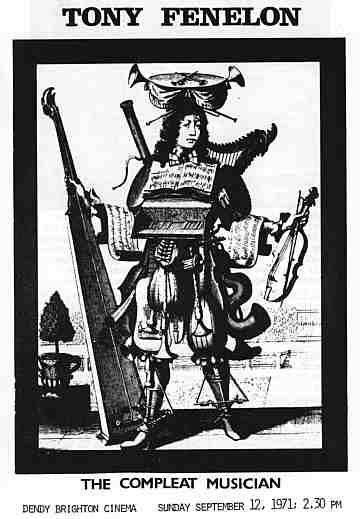
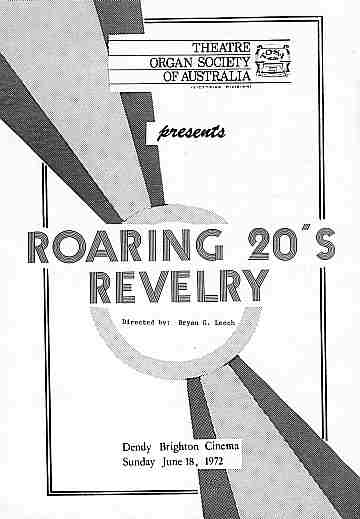
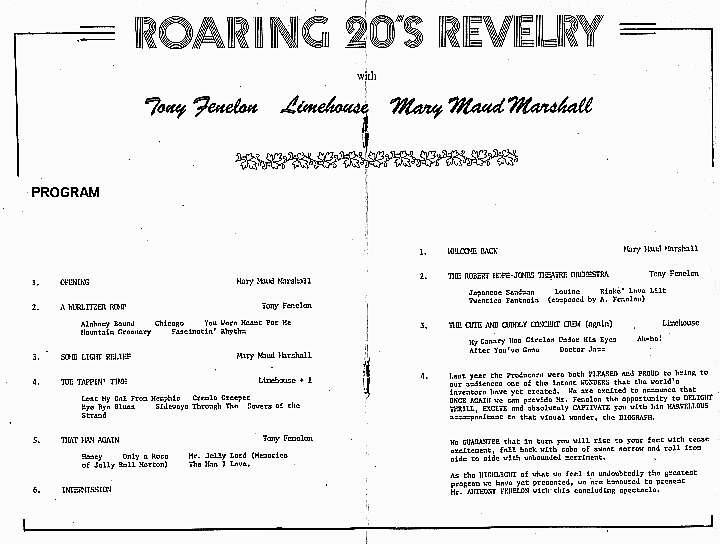
Programmeof a classic organ and jazz band concert, including combo numbers. Thirty years later it is still remembered as an all-time classic concert
In 1974, the Dendy Wurlitzer console was removed temporarily from the theatre, initially for rewiring. It was soon decided to extend the work to encompass releathering of all pneumatics within the console, and the replacement of the combination piston setter board, the last task alone requiring the installation of a new board with 1490 three-way switches and forty cables containing a total of 2200 wires. [Vox, March, 1976, p. 4] The console returned to the theatre in 1975, and the organ was used for an "open console" session at the Easter Convention that year, but without pistons or percussions. The rebuilding work was completed during 1976.
.jpg)
The console in 1975 without thumb pistons
.jpg)
During the late 1970s, rumours began to spring up that the Dendy theatre would close and a new home would have to be found for the organ. [Vox,November-December, 1979, p. 3] In December, 1979, The Herald carried an article about the Dendy organ, concluding with the following sad news:
"But the organ is soon to be homeless. The Dendy owners are planning to pull down the huge Brighton picture house to replace it with a smaller theatre and shopping arcades.
The Theatre Organ Society is on the look-out for a new auditorium and a possible $200,000 to relocate its tune..." [Quoted in SA TOSA News, TOSA (SA), Adelaide, January-February, 1980, p. 12]
TOSA (Vic) set up a sub-committee in January, 1980, to find a new home, and to arrange for the orderly removal and storage of the organ when that became necessary; at that stage no firm date for the theatre's closure had been announced. [Vox, January, 1980, p. 7] Uncertainty reigned through 1980, until in October, a startling announcement appeared in a local newspaper in its report on plans lodged with the Brighton Council for the theatre redevelopment project:
"A feature of the development would be the restoration of the organ now sitting in the Dendy Theatre.
Mr McConchie [Brighton town planner] said: 'The organ would be placed in a glass-fronted box which would face the Street.'" ["Exciting Project for Church Street", Southern Cross, 22 October, 1980, p. 14]
The breaking of this story caused some consternation initially within TOSA, as no official discussions had been held over this new plan with the Dendy management, and at the time, TOSA was still seeking a new home elsewhere in the Melbourne area for the organ. [Vox, November, 1980, p. 5] Despite much initial disbelief, the plans to retain the organ in one of the two new cinemas to be built in the complex progressed, and when the David Johnston, John Atwell and Tony Fenelon played the first of a series of farewell concerts on 23 May, 1982, it was an occasion of looking forward to the organ's rebirth in the new theatre. [SA TOSA News, TOSA (SA) Adelaide, June, 1982, p. 10]
In early 1983, the idea of installing the organ in a glass box was dropped:
"The architects for the Dendy Cinema redevelopment have changed the basic plan for the reinstallation of the Society's Wurlitzer.
The new plan provides organ chambers behind the screen, in much the same way as the existing installation. Originally it was planned to house the whole of the organ in a glass box elevated above the shopping plaza, with ducting leading to a wide grille in the left-hand side wall of the cinema. Subsequently, this somewhat naïve concept was abandoned in favour of main and solo chambers on either side of the auditorium, only with the main and solo chambers reversed. This was to enable the more visually interesting solo chamber to be seen behind glass.
Now it is proposed to place the chambers behind the screen, as was suggested by TOSA Trustees after considering the original plaza proposal. It is suggested that there should be a glass wall at the left hand end of the chamber facing into the shopping plaza. Architect Terry Edwards has said there will be workshop and blower space made available in the same position as the divided chamber arrangement. The new plan shows extensive use of curtains around the screen and side walls of the theatre, which will affect the acoustics, and will need to be considered in conjunction with the reduced volume of the new, smaller, auditorium.
There are a number of matters still to be resolved. With regard to the organ, these include the placement of the console, the location of the 32 foot diaphones - massive pipes which occupy a lot of space - and the organ's piano - an upright instrument without a keyboard, which is nothing much to look at..." ["Change to Dendy Installation", Vox, February, 1983]
The organ was removed from the theatre in December, 1983, and demolition of the theatre commenced in January, 1984. [Thiele, John, "Farewell, Dendy Theatre", SA TOSA News, TOSA (SA), Adelaide, June, 1984, p. 3] By July, work was well in hand on the construction of the new theatre, and TOSA hoped to receive the go-ahead to start installing the organ within the next twelve to sixteen weeks. Meanwhile, the opportunity was being taken to overhaul it. It was not certain whether it would the installation would be completed in time for the theatre's opening. [Vox, July, 1984] The new theatre opened in May, 1985, as the Brighton Village Twin-Cinema One. A progress report on the organ in November of that year stated that the installation of the organ was well under way, and it was hoped it would be ready in early 1986. [SA TOSA News, TOSA (SA), Adelaide, November, 1985, p. 7]This hope was not realised, as the overhaul of the organ became more extensive, and included the installation of a solid-state relay system. In November, 1987, TOSA announced that the organ would be opened on 17 April, 1988. [Vox, November, 1987]
There were two opening concerts on 17 April, 1988, to enable all those who wished to attend to be accommodated in the auditorium, which is roughly half the size of the old Dendy Theatre. Tony Fenelon performed the opening rites, commencing his programme with "On a Wonderful Day Like Today". David Johnston, John Atwell and two young local organists, Kah Kit Yoong and Terezia Kalkbrenner joined Tony in making it a day to remember. [Bertram, Wayne, "The Dendy Organ Re-Lives For TOSA Melbourne", SA TOSA News, TOSA (SA), Adelaide, May, 1988, p.12]
The organ chambers are located on the stage, containing the same fifteen ranks of pipes as in the Dendy (and Capitol), with the console now on the right, not on a lift, but sliding out from the wall.
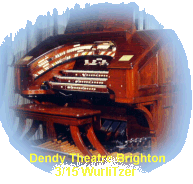
Dendy organ maintenance team member Cameron Simpson has kindly sent me the following excellent views taken of (and inside) the organ in 2002:
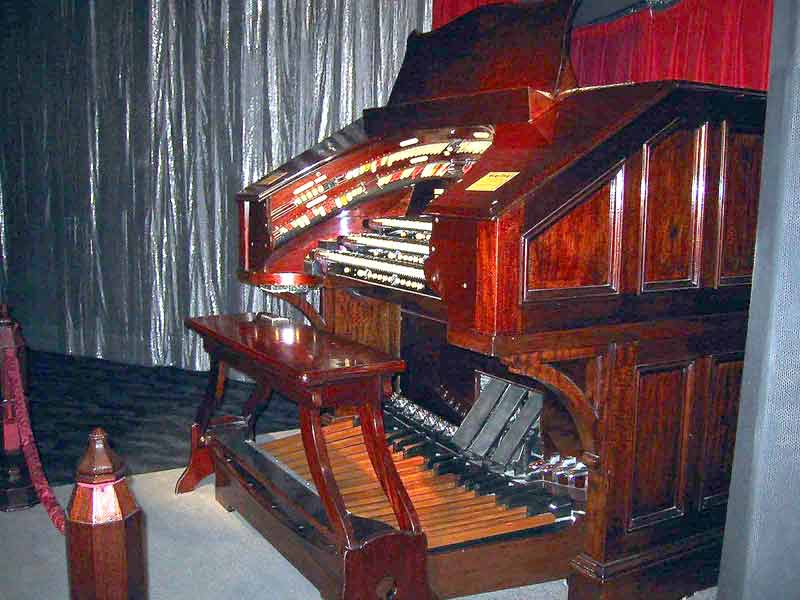
.jpg)
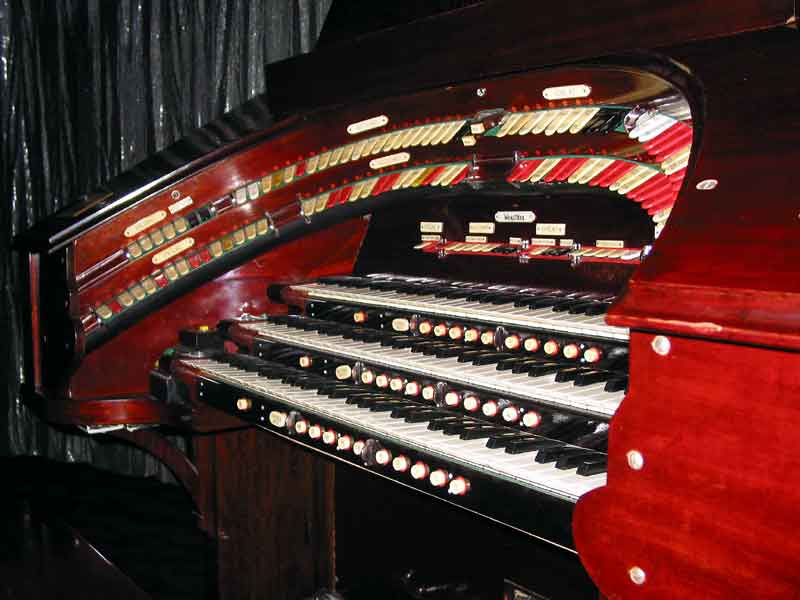
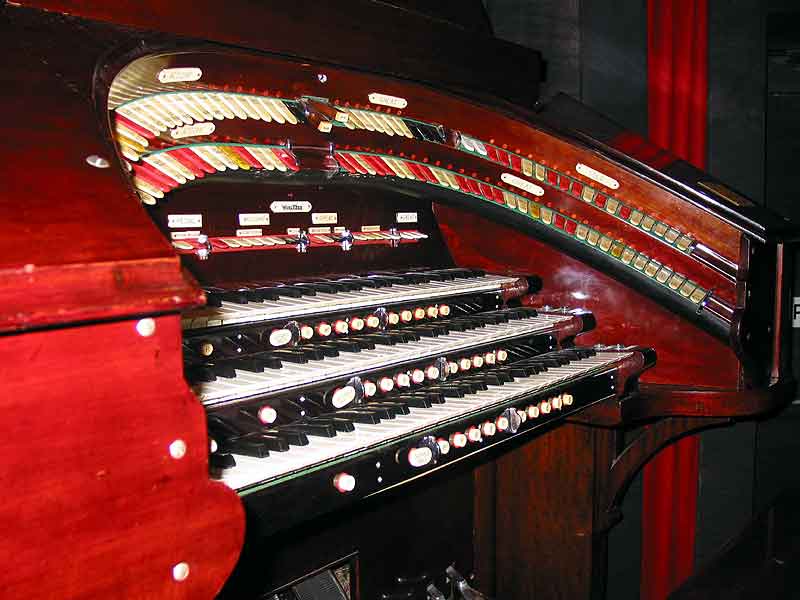
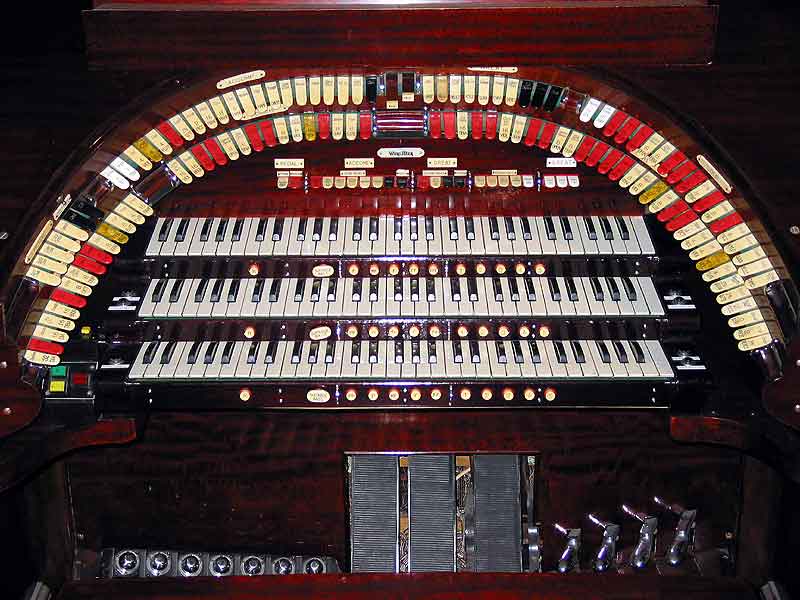
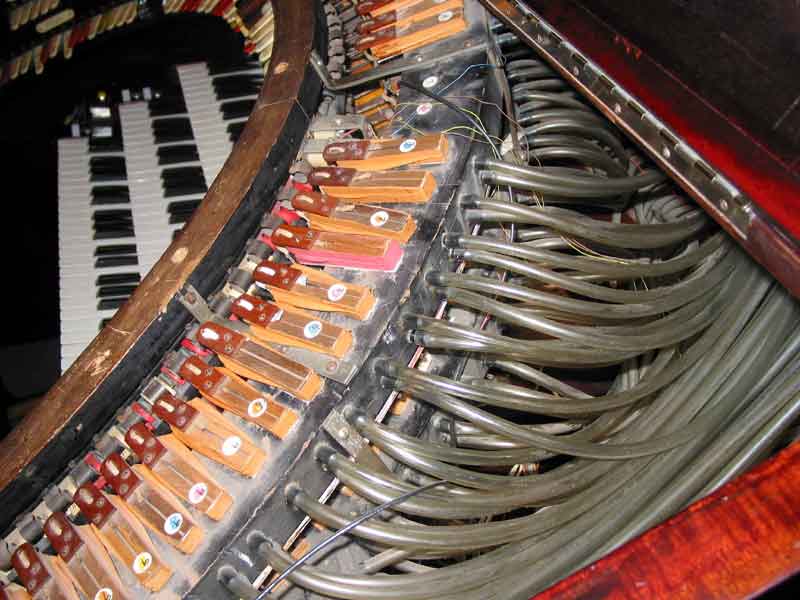
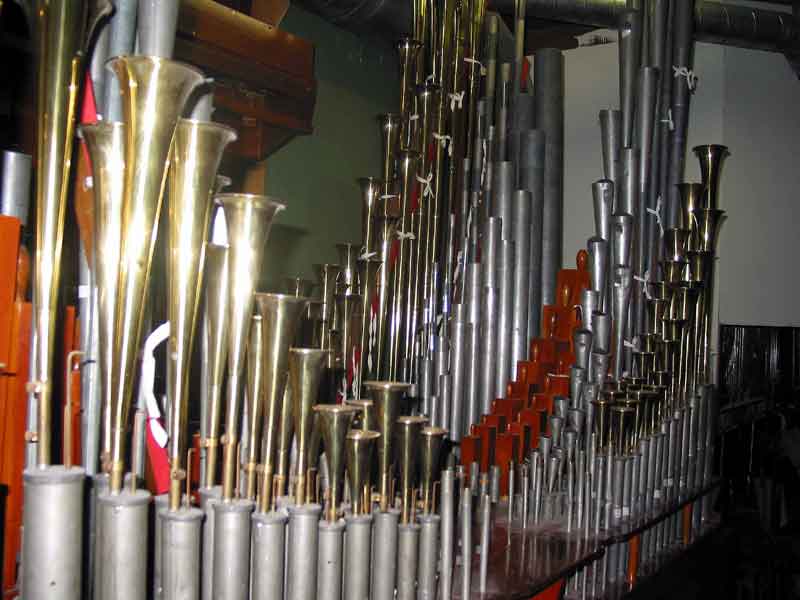
Solo Chamber
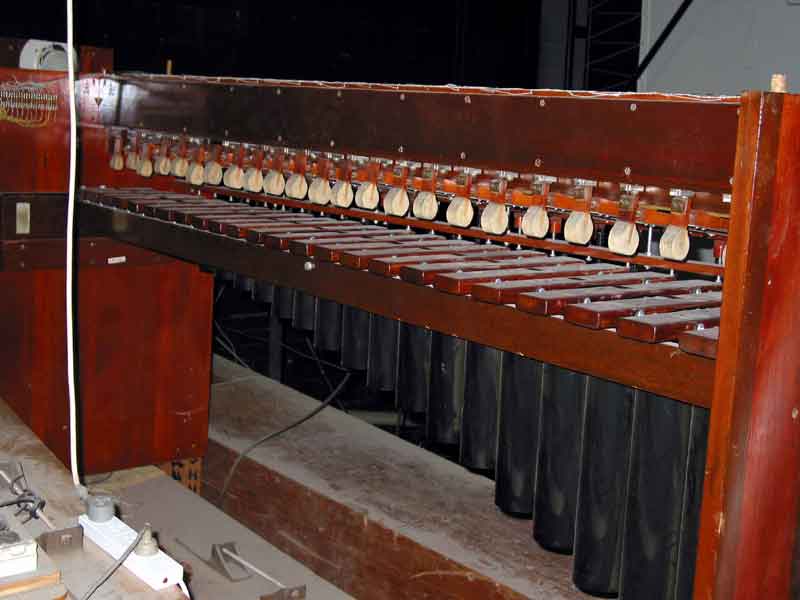
Marimba/Harp
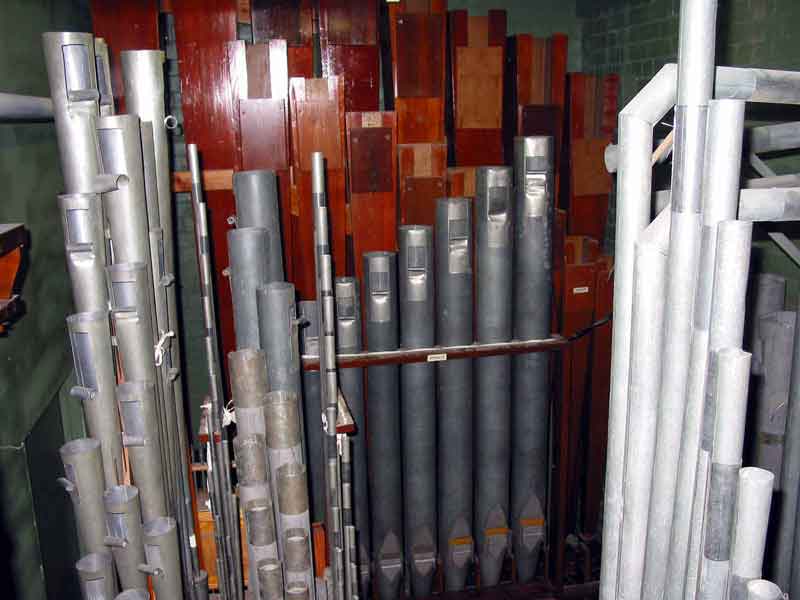
Main Chamber - "A Bunch of Diaphones"
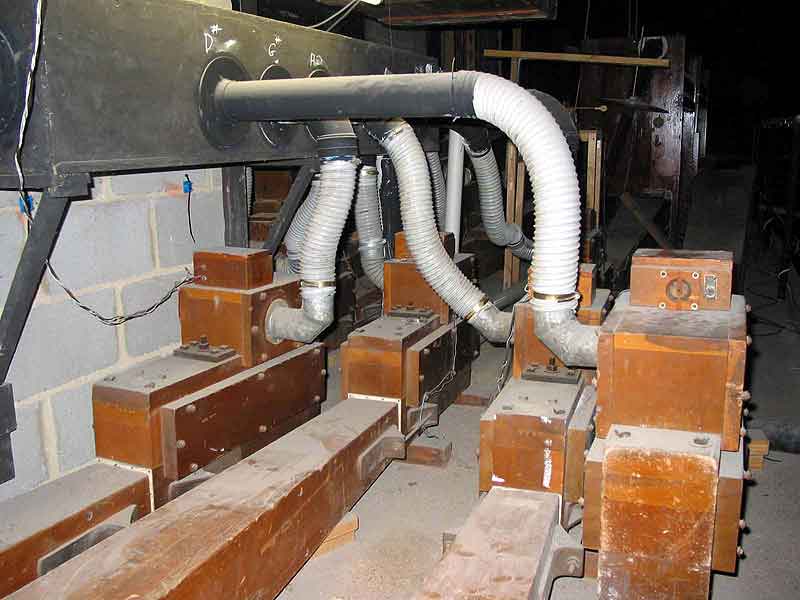
The largest Diaphones are on top of the chambers - the "pointy ends" (the beater units) are shown here, with the "octopus" that winds them
Above photographs by courtesy of Cameron Simpson
Like all theatre organs, the Dendy organ requires constant care and maintenance to keep it in top shape. The Maintenance Supervisor's report for 2000-2001 gives an idea of what is involved:
DENDY WURLITZER ANNUAL REPORT
This report on the Dendy Wurlitzer will be my last as I have now retired from the position.The organ will now be in the hands of Darren Everitt A much younger person than I. He has been a member of the team for quite a while now,and I have every confidence in his ability to look after this very valuable instrument,which it is planned to keep the organ in the utmost original condition.
Work on the organ mainly centered on the rebushing,relevelling and polishing of the keys,This work was performed by South Australian piano and organ technician Paul Fitzgerald.
Both myself and the work team have been overwhelmed by the positive feedback on the vast improvement of the organ.
Now for the future,work is partly underway for refurbishing of the rest of the console,when later this year all the stop actions will be rebuilt which will include releathering of the stop motors and complete replacement of the stop contact wires which have now become brittle and unreliable.
The work will be carried out by a new young team,who waiting ready to start the work.Because of the age of the Dendy work team members,the organ is assured of a very long and healthy life, and take the instrument into the requirements of today's style of playing.
I do now offer my sincere thanks to all members of the team, which is what we are at the Dendy,always ready to listen to the other person's point of view,and at least try it and not condemn it.
The team, Darren Everitt, Simon Moran, John Giacchi.Terry Georgiou, John Backman, and soon to join the team Max Rainer and Cameron Simpson.
A special thanks must go to the management of Palace theatres,and specially to Heather, David, Eric,Clinton and the rest of the staff at the Dendy Brighton for their outstanding assistance and cooperation over the past year.
Bruce M.Hester
Maintenance Supervisor [TOSA(Vic) website]
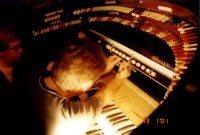
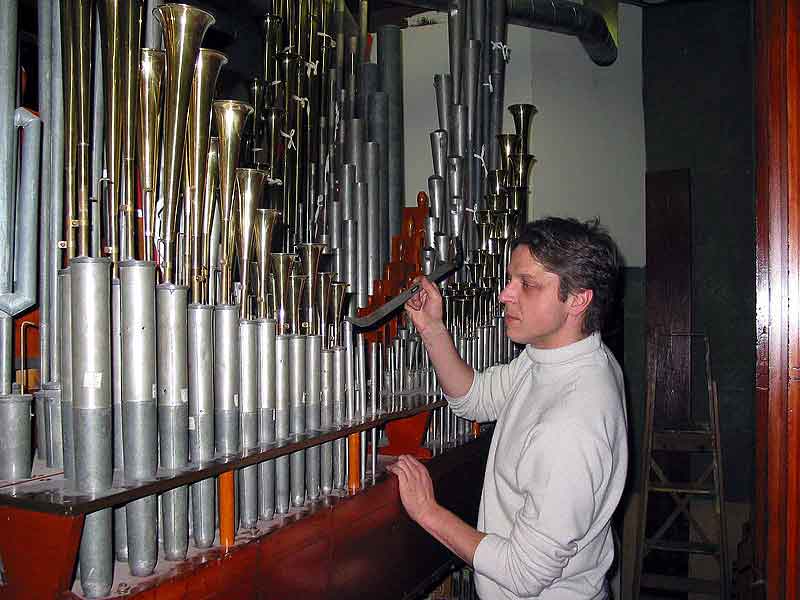
Darren Everitt tunes the Saxophone - photo: Cameron Simpson